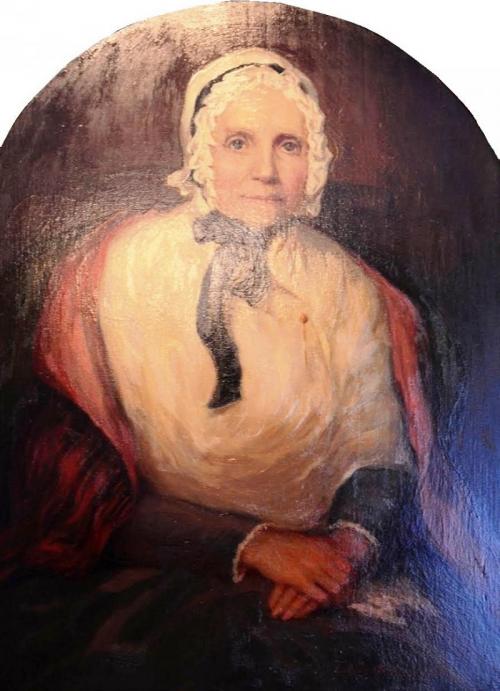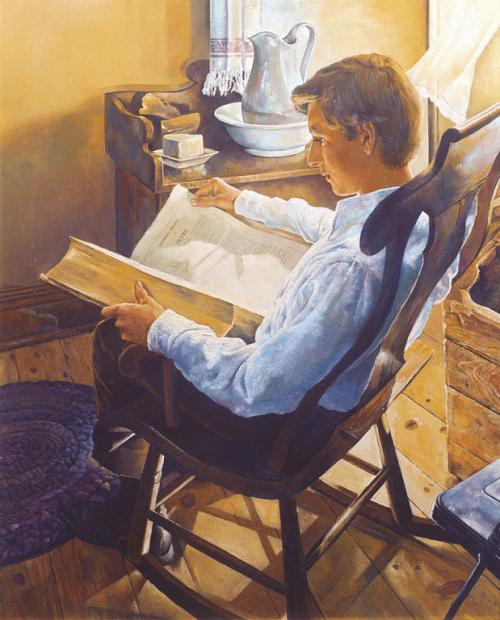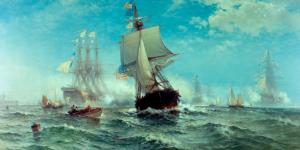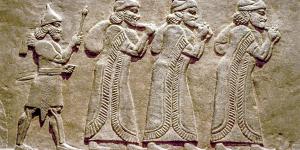You are here
Why Are There So Many Similarities between the Dreams of Lehi and Joseph Smith, Sr.?

1 Nephi 8:4
The Know
The opening chapters of the Book of Mormon preserve an account of a dream or vision of the tree of life granted to the prophet Lehi (1 Nephi 8). This vision contains many elements which have become familiar–––almost household–––among Latter-day Saint readers: a dark and dreary wilderness (v. 4), an angelic guide (v. 5), a large and spacious field (v. 9), the tree of life with white fruit (v. 10), a river of water (v. 13), a rod of iron (v. 19), a strait and narrow path (v. 20), mists of darkness (v. 23), and a great and spacious building (v. 26). Lehi’s Tree of Life vision has become iconic for its powerful symbolism and profound doctrine.
Remarkably, many of these elements are reported to have been witnessed by Joseph Smith, Sr. in a dream or vision he had many years before the coming forth of the Book of Mormon. As reported by Joseph Sr.’s wife, Lucy Mack Smith, the Smith family patriarch began experiencing peculiar dreams starting in the year 1811. During this time, according to Lucy, Father Smith, like his son Joseph some years later, “became much excited upon the subject of religion; yet, he would not subscribe to any particular system of faith.”1
Uncommitted to any particular religious denomination, Joseph Sr. sought after the true gospel of Jesus Christ on his own. Lucy recalled her husband deeply “contemplating the confusion and discord that reigned in the religious world” during that time.2 As preserved in Lucy’s memoir, Father Smith received the following vision during his period of religious questioning and seeking:
1811 Vision of Joseph Smith, Sr. 3
“I thought . . . I was travelling in an open desolate field, which appeared to be very barren; and while thus travelling, the thought suddenly came into my mind, that I had better stop and reflect upon what I was doing before I went any farther. So I asked myself, what motive can I have in travelling here, and what place can this be? My guide who stood by me, said; ‘this is the desolate world; but travel on.’ The road was so broad and barren, that I wondered why I shall should travel in it; for, said I to myself, broad is the road, and wide is the gate that leads to death, and many there be that walk therein; but narrow is the way, and straight is the gate that leads to everlasting Life, and few there be that go in thereat.” I travelled a short distance farther, and came to a narrow path; I entered it, and traveling a short proceeding some distance farther, beheld a beautiful stream of water, which ran from the east to the west. Of this stream, I could see neither the source nor the outlet < its mouth >; but as far as my eyes could extend, I could see a rope running along the bank, about as high as a man could reach; and beyond me was a low but very pleasant valley, in which stood a tree, such as I had never seen before: it was exceedingly handsome, insomuch that I looked upon it with wonder and admiration: its beautiful branches spread themselves, somewhat, in the form of an umbrella; and it bore a kind of fruit, in shape, much like a chesnut burr, and as white, or whiter than snow:
“I gazed upon the fruit with considerable interest— presently the burrs or shells began to open, and shed their particles, or the fruit which they contained, which was of dazzling whiteness. I drew near and began to eat of it, and I found it delicious beyond description; and, as I was eating, I said in my heart, I cannot eat this alone, I must bring my wife and children, that they may partake with me. Accordingly, I went and brought the family; which consisted of a wife and seven children; and we all commenced eating and praising God for this blessing— we were exceedingly happy, insomuch that our joy could not easily be expressed. While we were engaged in this manner, I beheld a spacious building, standing opposite the valley that we were in, which building appeared to reach to the very heavens. It was full of doors and windows, and they were all filled with people that were very finely dressed: when these people observed us in the low valley, under the tree, they pointed the finger of scorn at us; and treated us with all manner of disrespect and contempt. But their contumely we utterly disregarded. I soon turned to my guide, and inquired of him, the meaning of the fruit. He told me it was the pure love of God shed abroad in the hearts of all those who love him and keep his commandments. He then commanded me to go and bring the rest of my children— I told him we were all there. ‘No; he replied, ‘look yonder, you have two more, and you must bring them also.’ So I raised my eyes, and I saw two small children, standing some distance off. I immediately went to them and brought them to the to the tree; and they commenced eating with the rest; and we all rejoiced together. The more we eat the more we seemed to desire, until we even got down upon our knees, and scooped it up, eating it by double-hand-fulls.
“After feasting in this manner a short time, I asked my guide what was the meaning of the spacious building that I saw. He replied, ‘it is Babylon, it is Babylon; and it must fall: the people in the doors and windows, are the inhabitants thereof; who scorn and despise the saints of God because of their humility.’ I soon awoke, clapping my hands together for joy.”
Several parallels between Lehi’s and Joseph Sr.’s visions are immediately recognizable:
|
LEHI’S TREE OF LIFE VISION (1830 BOOK OF MORMON) |
JOSEPH SMITH, SR.’S 1811 VISION (LUCY SMITH 1845 HISTORY) |
|---|---|
|
“a large and spacious field” |
“an open desolate field” |
|
“I saw a man . . . and he came and stood before me” |
“My guide who stood by me” |
|
“a straight and narrow path” |
“a narrow path” |
|
“a river of water” |
“a beautiful stream of water” |
|
“a rod of iron; and it extended along the bank of the river” |
“a rope running along the bank” |
|
“a tree” |
“a tree” |
|
“the fruit thereof was white, to exceed all . . . whiteness” |
“a kind of fruit . . . as white, or whiter than snow.” |
|
“I beheld that it [the fruit] was most sweet, above all that I ever had before tasted” |
“I found it [the fruit] delicious beyond description” |
|
“I began to be desirous that my family should partake of it also” |
“as I was eating, I said in my heart, I cannot eat this alone, I must bring my wife and children” |
|
“…[the] fruit was desirable, to make one happy” |
“we were exceedingly happy, insomuch that our joy could not easily be expressed” |
|
“on the other side of the river of water, a great and spacious building; and it stood as it were in the air, high above the earth” |
“I beheld a spacious building, standing opposite the valley that we were in, which building appeared to reach to the very heavens” |
|
“it was filled with people, both old and young, both male and female; and their manner of dress was exceedingly fine” |
“filled with people that were very finely dressed” |
|
“they were in the attitude of mocking and pointing their fingers” |
“they pointed the finger of scorn at us; and treated us with all manner of disrespect and contempt” |
|
“but we heeded them not.” |
“But their contumely [insults] we utterly disregarded” |
These parallels demonstrate a clear relationship between the Book of Mormon and Lucy’s recounting of her husband’s dream. Because Lucy remembered Joseph Sr. having this dream in 1811, years before the publication of the Book of Mormon, the skeptical view has usually been that Joseph Smith merely used details of his father’s dream and reworked them into his own text.4 For many reasons, however, the skeptical view is debatable.
Because “there is no evidence that Lucy Mack Smith committed her material to writing before 1845, and because the Book of Mormon was written in 1829,” questions about the direction of textual dependence between these two sources can justifiably be raised.5 It could just as easily be argued, and indeed seems more likely, that Lucy’s account, or the sources she relied on (more on this below), is dependent on the text of the Book of Mormon.
For instance, Lucy’s retelling of her husband’s dream includes this passage: “I soon turned to my guide, and inquired of him, the meaning of the fruit. He told me it was the pure love of God shed abroad in the hearts of all those who love him and keep his commandments.”6 This language is drawn directly from Nephi’s own explanation for the meaning of the tree of life: “It is the love of God, which sheddeth itself abroad in the hearts of the children of men” (1 Nephi 11:22, emphasis added).7
Recent analysis by Sharalyn D. Howcroft indicates a complex compositional history behind Lucy’s memoir which further complicates matters.8 Based on her research, Howcroft concluded that Lucy’s history was “an even more layered production” than previously realized, which should encourage “historians to begin using Lucy’s history with caution.”9 The layers uncovered by Howcroft include apparently significant scribal input and editing by Martha and Howard Coray, who acted as Lucy’s scribes in the production of her history.
Rather than being “a work of singular authorship,”10 as it has been routinely understood by average readers, Lucy’s history should more appropriately be viewed as “an example of scribal publication that heavily draws upon pre-existing texts to flesh out the lives of the extended Smith family.”11 Besides the sources identified by Howcroft,12 including potentially a source from Joseph Sr.,13 it seems likely from the example above that Lucy’s history also drew from the language of the Book of Mormon and other scriptures.14 In light of this, since there is no extant firsthand source for the vision from Joseph Sr.,15 much less one which predates the published Book of Mormon, “the complex nature of possible influences in narrating [Joseph Sr.’s] dream experience over so lengthy a period of time is beyond any certain reconstruction.”16
None of this is to say that Lucy or the Corays were intentionally lying or deceitful in how they told the account of Joseph Sr.’s vision. Authorial and editorial practices in the nineteenth century were not always as rigid as they are today, and scribes often reformatted or repurposed source material as they felt appropriate to craft a compelling story.17 It would therefore be unfair to judge Lucy or the Corays based on modern editorial standards. Rather, this point is brought up merely to raise awareness of the high probability that Lucy’s retelling of the dream Joseph Sr. had over thirty years before the time of its recording was heavily influenced by the language of the Book of Mormon.18
The Why
The prophet Joel foretold a time when God would “pour out [his] spirit upon all flesh; and your sons and your daughters shall prophesy, your old men shall dream dreams, your young men shall see visions” (Joel 2:28). Before accepting the restored gospel in 1830,19 Joseph Sr. was a religious “seeker,” or one “who took the Bible and personal prayer seriously but felt that mainstream Christianity had departed from the Bible” and so sought after the pure teachings of Christ on his own.20 He was a man of great faith, but also skeptical of the religious denominations of his day.21
In accordance with Joel’s prophecy, Joseph Sr.’s faith was strong enough that, like his son, he was blessed with remarkable dreams and visions.22 There can be little doubt that Joseph Sr.’s visions played an important role in prompting him to believe the testimony of his son Joseph concerning the coming forth of the Book of Mormon and to finally join himself to a religious denomination by becoming a member of the restored church of Jesus Christ.
Skeptics might dismiss the similarities between Joseph Sr.’s and Lehi’s dreams as evidence of fraud (an idea never entertained by any members of the Smith family). But that need not be the default conclusion. Whatever role the Book of Mormon likely had in shaping Lucy Smith’s memory of her husband’s dream (or in shaping Joseph Sr.’s own memory of the dream as preserved by Lucy), there is nothing preventing God from granting comparable visions to spiritually inquisitive men and women from any time or place.23
Speaking of spiritual gifts, including gifts of revelation and prophecy, the prophet Moroni exhorted his readers to “remember that [God] is the same yesterday, today, and forever, and that all these gifts of which I have spoken, which are spiritual, never will be done away, even as long as the world shall stand” (Moroni 10:19).
Further Reading
Richard Lloyd Anderson, “Joseph Smith’s Home Environment,” Ensign, July 1971, online at lds.org.
Donald L. Enders, “Faithful from the First,” Ensign, January 2001, online at lds.org.
“Joseph Smith’s New England Heritage,” in Church History in the Fulness of Times Student Manual (Salt Lake City, UT: The Church of Jesus Christ of Latter-day Saints, 2003), 15–27.
Book of Mormon Central, “How Did the Book of Mormon Help the Early Saints Understand Spiritual Gifts?” KnoWhy 299 (April 12, 2017).
Sharalyn D. Howcroft, “A Textual and Archival Reexamination of Lucy Mack Smith’s History,” in Foundational Texts of Mormonism: Examining Major Early Sources, ed. Mark Ashurst-McGee, Robin Jensen, and Sharalyn D. Howcroft (New York, NY: Oxford University Press, 2018), 298–335.
- 1. Lucy Mack Smith, History, 1845, 52, online at josephsmithpapers.org.
- 2. Lucy Mack Smith, History, 52.
- 3. Lucy Mack Smith, History, 53–55
- 4. Fawn M. Brodie, No Man Knows My History: The Life of Joseph Smith, 2nd rev. ed. (New York, NY: Knopf, 1971), 58; Dan Vogel, Joseph Smith: The Making of a Prophet (Salt Lake City, UT: Signature Books, 2004), 14–15, 131, 395.
- 5. C. Wilfred Griggs, “The Book of Mormon as an Ancient Book,” in Book of Mormon Authorship: New Light on Ancient Origins, ed. Noel B. Reynolds (Provo, UT: FARMS, 1982), 95n4.
- 6. Lucy Mack Smith, History, 54–55, emphasis added.
- 7. See The Book of Mormon: An Account Written by the Hand of Mormon, upon Plates Taken from the Plates of Nephi (Palmyra, NY: Joseph Smith Jr., 1830), 25, online at josephsmithpapers.org.
- 8. Sharalyn D. Howcroft, “A Textual and Archival Reexamination of Lucy Mack Smith’s History,” in Foundational Texts of Mormonism: Examining Major Early Sources, ed. Mark Ashurst-McGee, Robin Jensen, and Sharalyn D. Howcroft (New York, NY: Oxford University Press, 2018), 298–335.
- 9. Howcroft, “A Textual and Archival Reexamination of Lucy Mack Smith’s History,” 299.
- 10. Howcroft, “A Textual and Archival Reexamination,” 323.
- 11. Howcroft, “A Textual and Archival Reexamination,” 325, emphasis added.
- 12. Howcroft, “A Textual and Archival Reexamination,” 307–315.
- 13. Howcroft, “A Textual and Archival Reexamination,” 324–325, has pointed out that “the dominant use of first-person point of view in [the account of Joseph Sr.’s vision] suggests it was “not dictated by Lucy but came from earlier manuscripts written by Joseph Smith Sr. prior to his death in 1840.”
- 14. See also Lucy Mack Smith, History, 14 (=Matthew 6:20), 70 (=Psalm 136:1), 142 (=Luke 18:4); Lucy Mack Smith, History, 1844–1845, page [2], bk. 14 (=Ecclesiastes 12:7; Matthew 6:23), online at http://www.josephsmithpapers.org. These and many additional biblical citations and allusions have been identified throughout Lucy’s history by Lavina Fielding Anderson, ed., Lucy’s Book: Critical Edition of Lucy Mack Smith’s Family Memoir (Salt Lake City, UT: Signature Books, 2001), passim.
- 15. A description of the vision of Joseph Sr. with the clear parallels to Lehi’s vision is not extant in any of the Corays’ earlier sources, being preserved in the manuscript known today as Fair Copy 2. Howcroft, “A Textual and Archival Reexamination,” 312, n. 50.
- 16. Griggs, “The Book of Mormon as an Ancient Book,” 95, n. 4.
- 17. Howcroft, “A Textual and Archival Reexamination,” 326. This is also evident in much of Joseph Smith’s published history. See the discussion in Dean C. Jessee, “The Writing of Joseph Smith’s History,” BYU Studies 11, no. 4 (1971): 439–473; “The Reliability of Joseph Smith’s History,” Journal of Mormon History 3 (1976): 23–46.
- 18. See further Blake T. Ostler, “The Book of Mormon as a Modern Expansion of an Ancient Source,” Dialogue: A Journal of Mormon Thought 20, no. 1 (Spring 1987): 71.
- 19. Joseph Sr. was baptized into the newly organized Church of Christ by Oliver Cowdery on April 6, 1830. See “Smith, Joseph, Sr.,” online at josephsmithpapers.org.
- 20. Donald L. Enders, “Faithful from the First,” Ensign, January 2001, 52; Richard L. Anderson, Joseph Smith’s New England Heritage, rev. ed. (Salt Lake City and Provo, UT: Deseret Book and BYU Press, 2003), 141–142.
- 21. “Joseph Sr. hungered for the truth. But he felt that attending no church at all was preferable to the wrong one. Following the counsel of his father, Joseph Sr. searched the scriptures, prayed earnestly, and believed that Jesus Christ had come to save the world. Yet he could not reconcile what he felt to be true with the confusion and discord he saw in the churches around him.” See “Ask in Faith,” in Saints: The Story of the Church of Jesus Christ in the Latter Days, online at history.lds.org.
- 22. Lucy recounted at least seven visions which her husband had during approximately the years 1811–1819. Howcroft, “A Textual and Archival Reexamination,” 312; A. Gary Anderson, “Smith, Joseph Sr.,” in Encyclopedia of Mormonism, 4 vols. ed. Daniel H. Ludlow (New York, NY: Macmillan, 1992), 3:1348.
- 23. Scripture preserves many accounts of prophets sharing similar visionary experiences. For example, Nephi and John saw the same vision of the last days (1 Nephi 14:18–30). Concerning the vision of the sons of perdition, the Lord declared, “Nevertheless, I, the Lord, show it by vision unto many, but straightway shut it up again” (Doctrine and Covenants 76:47). Throne theophanies are likewise often very similar in scriptural accounts. See Book of Mormon Central, ‟How Did God Call His Prophets in Ancient Times?” KnoWhy 17 (January 22, 2016). In light of this, the idea that the Lord may have shown Joseph Sr. something very similar to the vision of the tree of life in the Book of Mormon isn’t nearly as much of a stretch, and in fact might even explain why Lucy retold her husband’s vision in language from the Book of Mormon in a way that would emphasize the similarities.
KnoWhy Citation
Related KnoWhys
Subscribe
Get the latest updates on Book of Mormon topics and research for free







